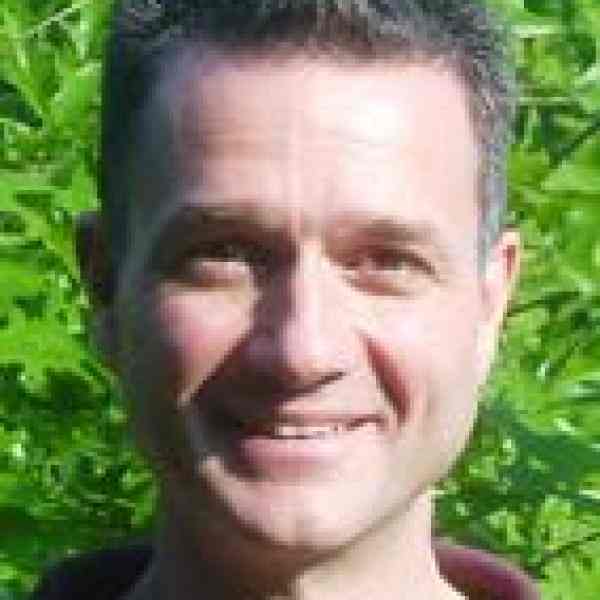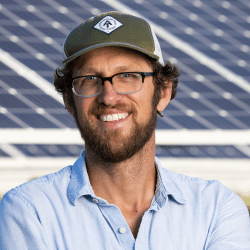Introduction
Fletcher Harper is tapping and activating the values base of the religious sector in ways profound and practical to curb wasteful consumerism and set faith-based communities on a track to environmental stewardship—in practice as well as in belief.
The New Idea
An Episcopal priest, Fletcher sees that spiritual communities in America represent, collectively, an enormous lever for environmental stewardship that is transformational, in its appeal and impact. Working through a deliberately interfaith approach, he offers a customizable action framework that supports spiritual communities in embracing care for the earth as a core value, finding its roots in their spiritual tradition, and connecting these concretely to the actions and consumer practices of their houses of worship and members. He cultivates leaders—seventy GreenFaith Fellows since 2006—and influencers within various faith communities and helps them along a changemaking ladder, so that they gain an interfaith peer group and the skill and self-permission to guide transformational environmental stewardship in their communities. Fletcher reaches and supports congregations directly as well through a certification program, structured as a rigorous two-year commitment, that guides participating groups as they embed a host of environment-friendly practices into the way they worship, what they consume (i.e. energy, food, cleaning products, and Styrofoam), and the policies they promote to create cleaner environments in heavily polluted areas. Having begun in 2009, the certification program now has thirty-five participating congregations—mosques, synagogues, churches, and so on—at various stages of adoption, with some “graduating” and beginning to mentor new congregations. Fletcher aims to realize wide impact over the next decade, bringing a broad faith-based network into the environmental action fold and positioning the religious sector as a key ally and distribution network and partner for utilities, environmental groups, and so on.
The Problem
Mainstream environmentalism in the U.S. has largely sprung from and been advanced by progressive liberals, and is positioned largely as a political issue. The profound personal experiences and the values inspired by the natural world and sustained across a broader values spectrum are not tapped fully as an inspiration for practical action or harnessed to shape the daily practice of reducing, reusing, and recycling.
Meanwhile, many of the world’s faiths hold care for the earth as a core tenet, embedded in scripture and in the stories of spiritual leaders. At the level of the congregation, the challenge of harnessing this deep values base for action is two-fold: First, the illumination of the connection of environmental action and faith has stayed at a theoretical or scholarly level, and few leaders of congregations have had the tools or sense of urgency to bring it into their weekly messages, much less make it a priority and embed it into the practice of their house of worship. The second barrier is that for faith-based communities, as for other groups, values held do not equal behaviors changed. When it comes to what consumer choices to prioritize, for example, it’s hard to figure out what actions are actually doable and important and in what timeframe. People and groups need guides and guides need to be well informed and able to connect behavior change on a small level (one congregation, for example) to the aggregate impact and change opportunity.
There are about 335,000 houses of worship and 250 theological seminaries in the United States, with about 60 million Americans attending service weekly. It’s a vast and influential social network, with a presence and typically a physical space in every town and city in the country. Yet, as Fletcher notes, many parts of it are not set up well to respond to the environmental crisis. The religious sector holds enormous potential for large-scale change, but is largely underperforming in terms of operations (e.g. volunteer teams respond to phone messages a week or two later) and fragmented among many insular denominations and actors. It’s a sector that needs consolidation, professionalism, and a reason to act quickly, purposefully, collaboratively, in ways that move beyond difference, and even in some cases fear and animosity.
The Strategy
Fletcher and his team and their growing network of GreenFaith Fellows and volunteers are introducing faith-based environmental stewardship through interlocking and reinforcing strategies that emphasize what’s actually practical and doable, and that mold to fit the stories, beliefs, and customs of various faith traditions, such as Islam, Christianity, Judaism, Hinduism, Buddhism and more.
Fletcher is cultivating leadership in various faith communities through a two-year Fellowship program. Fellows are carefully selected, and commit to four retreats, continuous learning about the environment and their faith tradition through monthly webinars with each other, and a follow-on leadership project, wherein they implement an environmental stewardship-themed project that aligns with the overall aim. In a few cases, the project has been to spearhead the implementation of the certification program within their congregations and effect a transformation in the culture of the congregation around this issue. The design of the Fellowship program is purposefully and deeply interfaith. Fellows pay $1,500 per person, signaling an investment not only of time but resources. Fletcher’s team gives roles to everyone: Fellows welcome new Fellows (assigned randomly) and mentor graduating Fellows (typically aligning interest or focus areas) and the retreat design is interlocking: Fellows graduating overlap one retreat with entering Fellows. In addition to sharing openly their faith background, the core issue of care for the environment, they are also tasked with taking back to the faith community the key learnings—spiritual and practical.
Fletcher also reaches congregations directly, and through a two-year certification program, he effects a transformation in the culture and operations. This, too, is well designed with longer-term adoption in mind and growth overall—along the lines of stewardship, justice, and spirit. Stewardship means practically how can the congregation adopt environment-friendly approaches; justice means a deliberate check in with low-income communities most affected by environmental degradation; and spirit means taking the environment message deep within with practice of their faith. Participating congregations do not take the commitment lightly; they are vetted to ensure that the right success factors are in place. If the house of worship is undergoing a large renovation, it may be too distracting a time. If there is an enthusiastic member who is unable to bring on board the clergy leadership, then not the right fit. The commitment comes from the clergy, who sign on and deliver a statement of intent publicly to the congregation and a “green team” from within the congregation, each of whose members personally sign a written commitment to stay with the change. The congregation is matched with a mentor from a more advanced “green team” who can offer coaching on matters ranging from what products to purchase, to how to introduce effective environmental education for teens and adults, to brainstorming ideas about how to mobilize a larger part of the community. Sometimes the matching happens because there is a fit with congregation size; where possible, the match is made to facilitate interfaith understanding (i.e. a Jewish mentor matched with a mosque).
Some examples of the kinds of stewardship changes some congregations have achieved include: A church in Austin, TX, set up a charging station for electric cars; a church in Chattanooga, TN, started a farmer’s market in their parking lot, accepting food stamps and reaching out to low-income customers; a temple cut their electricity and natural gas usage by one-third, saving $34,000 over two years; a congregation created a butterfly garden, and vegetable gardens; various congregations have installed solar panels; various other groups are implementing a “green” cleaning program.
In terms of justice, several congregations have organized “environmental justice tours” where they take members into low-income areas of town, near contaminated sites and incinerators, enabling responsive action in the form of reaching local representatives and participating in pollution reduction campaigns.
In the area of the spirit, congregations take their worship services outdoors as often as possible, and clergy offer powerful sermons that meld place with environmental themes already present in their scriptures. Some congregations focused a service on the oil spill this year. Some congregations are enhancing this theme, while others are starting it for the first time, provoked by the certification program.
Undergirding this is a commitment by GreenFaith’s team and the volunteers they mobilize to enact a shift in performance culture so that they embody the swift action they ask of others. Volunteer mentors are advised to respond to emails within 24 hours, for example. They offer honest feedback in monthly progress sessions, and share best practices. This helps to move along the whole, and encourage advancement toward goals on each of the three dimensions.
Finally, Fletcher has begun aggregating demand for the purchase and distribution of energy efficient products, and is developing partnerships with utilities, energy brokers, and financing groups, and helping to open utilities and renewable energy developers to the opportunity of partnering with faith-based communities to achieve profitable and environmental impact.
Fletcher’s team is based in New Jersey and is about five full-time employees. The skill sets represented on the team include: policy and advocacy, community sales, environmental science, sustainability, and communications and PR. The faith backgrounds include: Muslim, Jewish, Christian, and secular. GreenFaith’s budget is about $600,000, with most of the funding coming from foundations. In the past eight months, they have been activating an individual donor base as well. Fletcher sees the potential of earned income through, for example, taking a cut from utility company contracts, and is working this out.
The Person
Fletcher grew up in New York City. In fifth grade, he organized the first environmental initiative in his school’s history. He planned meetings of students, faculty and administrators, raised funds and in-kind support, and spoke publicly in numerous settings about the importance of the initiative. The result was a series of educational and service events that drew hundreds. Through this, Fletcher learned that he could rally people to a cause, leverage resources, and make an impact. In eighth grade, he began a decade’s effort in public speaking, developed foundational skills in this area, and became an excellent debater. He also recognized his affinity for spirituality, having been awakened inwardly by a number of powerful outdoor experiences.
Fletcher’s father died unexpectedly during his senior year in college. Grieving this loss offered important and deep lessons on learning about inner strength and compassion, and about recovering from loss. After graduating, in place of joining the Peace Corps, he raised several thousand dollars with a friend, bought a used van and interviewed sixty centenarians—people over 100 years of age—in ten states from coast to coast. Fletcher has published articles in regional and national periodicals, and placed segments on National Public Radio. He learned to raise foundation funds (and to deal with multiple rejection letters), sharpened his writing, and developed initial project management skills. During this project, he read Tom Peter’s In Search of Excellence and Alexander Solzhenitsyn’s A World Split Apart. Both authors called for creativity, courage, and effectiveness in addressing problems in businesses and society. Their call for purpose and innovation resonated deeply with Fletcher.
After stints in his early 20s as a foundation program officer in North Carolina, a public school teacher in Spanish Harlem, and an intake worker at a Harlem drug rehab facility, Fletcher entered Union Theological Seminary, known for preparing leaders for spiritual and moral activism. He was also a chaplain on a cancer ward for a year, and learned more about suffering and resilience. Fletcher then served as a parish priest for ten years, launching a child development center that was profitable within six months. He redesigned the ordination process for Episcopal clergy in his region to integrate stronger psychological testing and more rigorous standards.
After conducting several volunteer speaking engagements for GreenFaith’s small predecessor organization, Fletcher came to its helm in 2002 and within 15 months, he renamed the organization, secured new funding, and began creating the vehicle he needed to drive the vision forward at a national scale.




